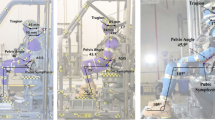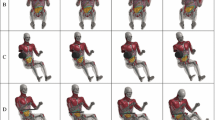Abstract
Many injury metrics are routinely proposed from measured or derived quantities from biomechanical experiments using post mortem human subjects (PMHS). The existing literature did not provide guidance on deciding between parameters collected in an experiment that would be best to use for the development of human injury probability curves (HIPC). The objective of this study was to use the Brier Metric Score (BMS) to identify the most appropriate metric from an experiment that predicts injury outcomes. The Brier Metric Score assesses how well a metric predicts the outcome for a censored data point (a lower BMS is better). Survival analysis was then conducted with the selected metric and the best distribution was selected using Akaike information criterion (AIC). Confidence intervals (CIs) and the normalized confidence interval width (NCIS) were calculated for the injury probability curve. The testing and validation of the methods described were performed using biomechanics data in the open literature. The methods for the HIPC development procedure detailed herein have been rigorously tested and used in the generation of WIAMan HIPCs and Injury Assessment Reference Curves (IARCs) for the WIAMan ATD, but can also be used in other ATD or PMHS injury risk curve development.




Similar content being viewed by others
References
Bailey, A. M., J. J. Christopher, F. Brozoski, and R. S. Salzar. Post mortem human surrogate injury response of the pelvis and lower extremities to simulated underbody blast. Ann. Biomed. Eng. 43:1907–1917, 2015.
Bailey, A. M., T. L. McMurry, G. S. Poplin, R. S. Salzar, and J. R. Crandall. Survival model for foot and leg high rate axial impact injury data. Traffic Injury Prev 16:S96–S102, 2015.
Baker, A., F. Hsu, and F. Gayzik. A method to measure predictive ability of an injury risk curve using an observation-adjusted area under the receiver operating characteristic curve. J. Biomech. 72:23–28, 2018.
Belsley, D. A., E. Kuh, and R. E. Welsch. Regression Diagnostics: Identifying Influential Data and Sources of Collinearity. New York: Wiley, 2005.
Cavanaugh, J. M., and N. Yoganandan. Thorax injury biomechanics. In: Accidental Injury, edited by N. Yoganandan, A. M. Nahum, and J. W. Melvin. New York: Springer, 2015, pp. 331–372.
Chirvi S., F. Pintar, N. Yoganandan, A. Banerjee, M. Schlick, W. Curry, and L. Voo. Human foot–ankle injuries and associated risk curves from under body blast loading conditions. SAE Technical Paper, 2017.
Cutcliffe H. C., A. L. Schmidt, J. E. Lucas and R. Cameron. How few? Bayesian statistics in injury biomechanics. SAE Technical Paper, 2012.
DeVogel, N., N. Yoganandan, A. Banerjee, and F. Pintar. Hierarchical process using Brier Score Metrics for lower leg injury risk curves in vertical impact. J. R. Army Med. Corps 2019. https://doi.org/10.1136/jramc-2018-001124.
Friess, S. H., R. N. Ichord, J. Ralston, K. Ryall, M. A. Helfaer, C. Smith, and S. S. Margulies. Repeated traumatic brain injury affects composite cognitive function in piglets. J. Neurotrauma 26:1111–1121, 2009.
Gabler, L. F., J. R. Crandall, and M. B. Panzer. Development of a second-order system for rapid estimation of maximum brain strain. Ann. Biomed. Eng. 47:1971–1981, 2019.
Kuppa S., R. H. Eppinger, F. McKoy, T. Nguyen, F. A. Pintar and N. Yoganandan. Development of side impact thoracic injury criteria and their application to the modified ES-2 dummy with rib extensions (ES-2re). SAE Technical Paper, 2003.
Lee, E. T., and J. W. Wang. Statistical Methods for Survival Data Analysis. New York: Wiley, 2013.
McMurry, T. L., and G. S. Poplin. Statistical considerations in the development of injury risk functions. Traffic Injury Prev 16:618–626, 2015.
Mendoza-Vazquez, M., J. Davidsson, and K. Brolin. Construction and evaluation of thoracic injury risk curves for a finite element human body model in frontal car crashes. Accid. Anal. Prev. 85:73–82, 2015.
Patalak, J. P., M. G. Harper, A. A. Weaver, N. M. Dalzell, and J. D. Stitzel. Estimated crash injury risk and crash characteristics for motorsport drivers. Accid. Anal. Prev. 136:105397, 2020.
Petitjean A. and X. Trosseille. Statistical simulations to evaluate the methods of the construction of injury risk curves. SAE Technical Paper, 2011.
Petitjean A., X. Trosseille, N. Praxl, D. Hynd and A. Irwin. Injury risk curves for the World SID 50th male dummy. SAE Technical Paper, 2012.
Pintar F. A., M. B. Schlick, N. Yoganandan, L. Voo, A. C. Merkle and M. Kleinberger. Biomechanical response of military Booted and Unbooted Foot-Ankle-Tibia from vertical loading. SAE Technical Paper, 2016.
Proctor, J. L., W. L. Fourney, U. H. Leiste, and G. Fiskum. Rat model of brain injury caused by under-vehicle blast-induced hyperacceleration. J. Trauma Acute Care Surg. 77:S83–S87, 2014.
Royston, P., and M. K. Parmar. Flexible parametric proportional-hazards and proportional-odds models for censored survival data, with application to prognostic modelling and estimation of treatment effects. Stat. Med. 21:2175–2197, 2002.
Salzar, R. S., W. B. Lievers, A. M. Bailey, and J. R. Crandall. Leg, foot, and ankle injury biomechanics. In: Accidental Injury, edited by N. Yoganandan, A. M. Nahum, and J. W. Melvin. Springer: New York, 2015, pp. 499–547.
Stemper, B. D., A. S. Shah, J. Harezlak, S. Rowson, J. P. Mihalik, S. M. Duma, L. D. Riggen, A. Brooks, K. L. Cameron, and D. Campbell. Comparison of head impact exposure between concussed football athletes and matched controls: evidence for a possible second mechanism of sport-related concussion. Ann. Biomed. Eng. 47:2057–2072, 2019.
Yoganandan, N., M. W. Arun, F. A. Pintar, and A. Szabo. Optimized lower leg injury probability curves from postmortem human subject tests under axial impacts. Traffic Injury Prev 15:S151–S156, 2014.
Yoganandan, N., A. Banerjee, F.-C. Hsu, C. R. Bass, L. Voo, F. A. Pintar, and F. S. Gayzik. Deriving injury risk curves using survival analysis from biomechanical experiments. J. Biomech. 49:3260–3267, 2016.
Yoganandan, N., N. DeVogel, J. Moore, F. Pintar, A. Banerjee, and J. Zhang. Human lumbar spine responses from vertical loading: ranking of forces via Brier score metrics and injury risk curves. Ann. Biomed. Eng. 48:79–91, 2020.
Yoganandan, N., J. R. Humm, N. DeVogel, A. Banerjee, F. A. Pintar, and J. T. Somers. Pelvis injury risk curves in side impacts from human cadaver experiments using survival analysis and Brier score metrics. Traffic Injury Prev 20(Suppl 2):S137–S142, 2019.
Yoganandan, N., B. D. Stemper, F. A. Pintar, D. J. Maiman, B. J. McEntire, and V. C. Chancey. Cervical spine injury biomechanics: applications for under body blast loadings in military environments. Clin. Biomech. 28:602–609, 2013.
Acknowledgments
Funding for this work was provided by the US Army WIAMan Engineering Office (W911QX-17-D-0006).
Author information
Authors and Affiliations
Corresponding author
Additional information
Associate Editor Stefan M. Duma oversaw the review of this article.
Publisher's Note
Springer Nature remains neutral with regard to jurisdictional claims in published maps and institutional affiliations.
Rights and permissions
About this article
Cite this article
Hostetler, Z.S., Hsu, FC., Yoganandan, N. et al. An Improved Method for Developing Injury Risk Curves Using the Brier Metric Score. Ann Biomed Eng 49, 3091–3098 (2021). https://doi.org/10.1007/s10439-020-02686-8
Received:
Accepted:
Published:
Issue Date:
DOI: https://doi.org/10.1007/s10439-020-02686-8




